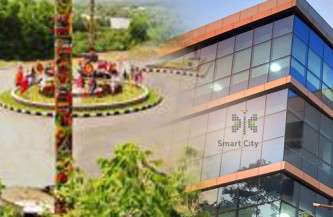What is a Challenge?

Ordinary people are capable of doing extraordinary things. For this they need to be trusted, encouraged and empowered.
– Azim Premji
Challenge simply means selection of cities through a competition. This is a paradigm shift from the earlier selection method in which a formula (e.g. city size) was used for selection. While designing the Challenge, the following principles were kept in mind.
- The Challenge has multiple stages. The Mission consists of several rounds and each round has two stages-shortlisting (Stage 1) and competitive (Stage 2). In Stage 1 States conducted an intra-state competition to select potential Smart Cities. The winners of Stage 1, then participated in an All-India competition (Stage 2) conducted by the Ministry of Urban Development.
- Started with the broadest feasible pool of applicants.In Stage 1 all all Cities were eligible to participate.
- Used judging criteria at the end of the process rather than pre-conditions as the way to select winners that conform to the Mission objectives. This stimulated participation and encouraged creative thinking.
- Judging criteria was different for the two stages. During Stage 1 potential Smart Cities were shortlisted based on the past performance. In Stage 2 competing cities had to prepare a Smart City Proposal (SCP). The SCP was future-oriented and prepared in close consultation with stakeholders. The format of the SCP was standardized and detailed; thereby,allowingcredible and verifiable comparisons across applicant cities.
- The judging criteria for the SCP were developed in close consultation with all stakeholders. In the Mission professionals, experts and participating States/Cities participated in the development of the criteria, which was clearly defined and well communicated from the beginning.
- Geographical equitywas ensured during Stage 1. While shortlisting 100 cities every State got atleast one potential Smart City.
- Significant effort was invested in each stage to encourage the most and best possible applications from cities. Consulting firms and multilateral and bilateral organizations agencies (e.g. World Bank, Asian Development Bank) provided handholding assistance.
- A Coalition of the Willingwas created. The Mission generated a complete buy-in of willing States/Cities.
How to do the competition among 100 cities?
There were to two ways to design the Challenge. One way was to start with a broad set of cities (say with population over one lakh ~500 cities) and select over time 100 Smart cities. In the second option, 100 potential Smart Cities would be identified in advance and the competition would be used to select cities to receive funding. Here, the 100 cities would be determined by a formula and would include atleast one city from each State/UT. The second option was chosen due to the following reasons:
- Inspire those cities that are looking for the Smart City label immediately and kick-start the Mission.
- Do the selection of 100 Smart Cities expeditiously (3 years).
- Deal with a smaller number of cities initially, as States will take time to acquire expertise to participate in competitions.
- Allow more cities to participate in the Challenge after Round 1. Adding new applicant cities will renew the competitive spirit.
The Challenge
Each aspiring city competes for selection as a smart city in the ‘City Challenge’. There are two stages to the selection process.
Stage 1 of the competition: Shortlisting of cities by States
The State began by shortlisting the potential smart cities on the basis of conditions precedent and scoring criteria and in accordance with the total number allocated to it. The first stage of the competition was intra-state, in which cities in the State competed on laid-out scoring criteria. The highest scoring potential smart cities were shortlisted. These 100 shortlisted cities were called potential smart cities and recommended to participate in Stage 2 of the Challenge.
Stage 2 of the competition: All India competition round for selection
In the second stage of the competition, each potential smart city prepared their proposals for participation in the ‘City Challenge’. This was a crucial stage as each city’s Smart City Proposal was expected to contain the strategy for making the whole city ‘smart’, complementary missions to provide basic services (e.g. water supply, sewerage), different types of smart solutions to be applied to infrastructure and services to improve them and the pathway showing the complete development of Areas (area-based development) one-by-one in order to make the full city ‘smart’. Naturally, the SCP also contained the financing and implementing plans. An evaluation criteria for the SCPs was worked out by MoUD based on professional advice and this acted as guidance to the cities for preparing their proposal.
By a stipulated date, proposals wereprepared by the 100 cities and submitted to the Ministry of Urban Development. These were evaluated by a Committee involving a panel of national and international experts, organizations and institutions. The winners of the first round of Challenge were announced by MoUD, thereafter. After this, the winning cities started action on making their city smart, those who do not get selected started to work on improving their SCPs for consideration in the second round.
Key takeaways from the Challenge
- The India Smart City Challenge is the first of its kind in India and possibly the world. It is also the first time that the Government of India is investing funds in urban development on the basis of a competitive selection at this large scale.
- The Challenge promoted a high level of partnership and cooperation between the State Governments and municipalities and the Government of India. This is the first time that an urban mission of such scale and ambition has relied so little on the decision-making by the Government of India. Such an approach is called “loose-fit, light touch”. In fact, what the Mission has adopted is an inside-out, bottom-up approach, such that the strengths and opportunities in Indian cities can be leveraged for comprehensive improvement of the built environment, local economy and quality of life of all citizens.
- Large citizen turnout is a testimony to the enthusiasm and hope with which citizens want to participate in the development of their cities provided they are given the opportunities to do so. The Challenge gave an incentive to citizens to participate in the planning of their cities because their preferences and demands count, now.





